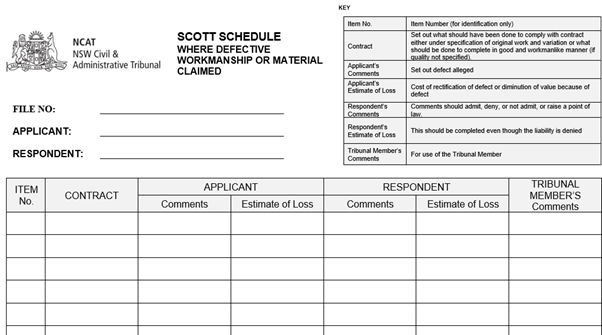NCAT SCOTT SCHEDULE FORMAT

Understanding the NCAT Scott Schedule
28/06/2024
What is a Scott Schedule?
03/07/2024An NCAT (New South Wales Civil and Administrative Tribunal) Scott Schedule is used in legal disputes, often related to building and construction cases, to help parties systematically present and compare their claims and defenses. Here’s how you can structure an NCAT Scott Schedule:
NCAT Scott Schedule Structure
- Item Number: Unique identifier for each item in dispute.
- Claimant’s Description of Issue: The claimant’s detailed description of the issue or defect.
- Claimant’s Claimed Cost: The amount the claimant claims for rectification or damages.
- Respondent’s Description of Issue: The respondent’s counter-description or denial of the issue.
- Respondent’s Offered Cost (if any): The amount the respondent is willing to pay or their assessment of the issue.
- Tribunal’s Decision: The Tribunal’s final decision on the issue.
- Comments/Notes: Any additional remarks or information.
Example NCAT Scott Schedule Format

#image_title
How to Use the Scott Schedule
- Item Number: Each issue should be given a unique item number for easy reference.
- Applicant’s Description of Issue: Clearly describe the defect or issue as the claimant sees it.
- Applicant’s Claimed Cost: Specify the cost the claimant believes is required to fix the issue.
- Respondent’s Description of Issue: The respondent provides their perspective on the issue, which may include a denial or an alternative explanation.
- Respondent’s Offered Cost: If the respondent acknowledges the issue but disputes the cost, they can offer an alternative amount.
- Tribunal’s Decision: This column is filled in by the Tribunal after they have considered both parties’ arguments and evidence.
Would you like assistance in creating a Scott Schedule for a specific NCAT case or dispute? If so, please provide the details, and I can help you set it up.
Notice: Trying to access array offset on value of type null in /home/awesimco/public_html/wp-content/themes/betheme/includes/content-single.php on line 286
Related posts
19/10/2024
Notice: Trying to access array offset on value of type bool in /home/awesimco/public_html/wp-content/themes/betheme/functions/theme-functions.php on line 1611
Notice: Trying to access array offset on value of type bool in /home/awesimco/public_html/wp-content/themes/betheme/functions/theme-functions.php on line 1611
25/07/2024




